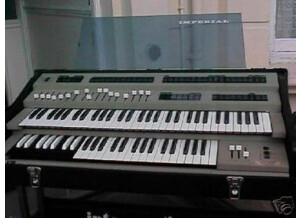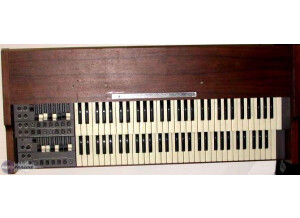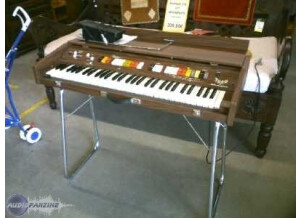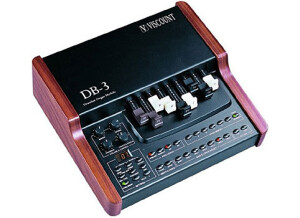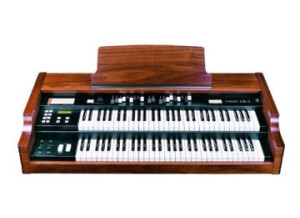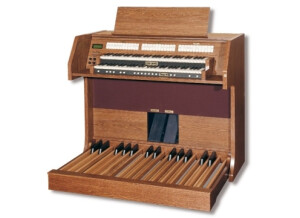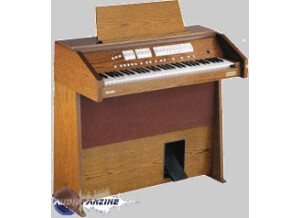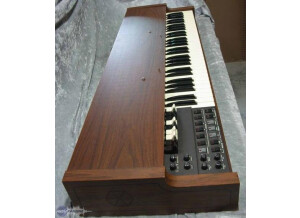Where to buy Cantorum VI?
Less
There are no classified ads for this product.
Tech. sheet
User reviews
5.0/5(1 reviews)
5
100 %
4
3
2
1
Perfect in its category
Published on 01/11/14 at 14:36 (This content has been automatically translated from French)Classic organ keyboard (liturgical) 61 notes. Type keyboard church organ, simulating the effect of valve (mechanical traction).
21 stops are divided into 3 sections: Bass (pedal) Accompaniment (story), Grand Organ.
4 styles organ (Baroque, Romantic, symphonic)
Some "orchestral" stops, such as Piano, Harpsichord, choirs, strings, etc..
Volume, reverberation, balance between sections by cursor. Possibility to connect a volume pedal (optional).
Midi In and Out. It is possible to connect a pedal board (27-32 notes).
UTILIZATION
You connect, you play ... The interface on the console is very ergonomic and requires only a few minutes to integrate basic functions are all on this type...…
21 stops are divided into 3 sections: Bass (pedal) Accompaniment (story), Grand Organ.
4 styles organ (Baroque, Romantic, symphonic)
Some "orchestral" stops, such as Piano, Harpsichord, choirs, strings, etc..
Volume, reverberation, balance between sections by cursor. Possibility to connect a volume pedal (optional).
Midi In and Out. It is possible to connect a pedal board (27-32 notes).
UTILIZATION
You connect, you play ... The interface on the console is very ergonomic and requires only a few minutes to integrate basic functions are all on this type...…
Read more
Classic organ keyboard (liturgical) 61 notes. Type keyboard church organ, simulating the effect of valve (mechanical traction).
21 stops are divided into 3 sections: Bass (pedal) Accompaniment (story), Grand Organ.
4 styles organ (Baroque, Romantic, symphonic)
Some "orchestral" stops, such as Piano, Harpsichord, choirs, strings, etc..
Volume, reverberation, balance between sections by cursor. Possibility to connect a volume pedal (optional).
Midi In and Out. It is possible to connect a pedal board (27-32 notes).
UTILIZATION
You connect, you play ... The interface on the console is very ergonomic and requires only a few minutes to integrate basic functions are all on this type of instrument. An organist will navigate instantly! The manual is clear and will be useful for finding some advanced features like the volume control of each stop if we want to "customize" the instrument, or change the speed and depth of the tremolo, for example. Or navigate in the Midi setup.
SOUNDS
Here attention .... I am VERY DEMANDING on these points: being accustomed to the great organ (those with full pipe and breath in the bronchi), play on a digital artifact can leave hungry ... You should know that no two organs (acoustic, I mean) sound identical, not even the feel of the keyboard response.
Viscount Cantorum VI gave me great and pleasant surprises (taking into account the category of the instrument, of course!)
- The classic organ sounds (imitation pipe organ): Rather good, very good to see some games, even if the sample is short loop *, post processing and recording functions chorus and Temperament improve the sound. 4 types of organ provided are really different from each other, it is as if there are 4 different instruments! Not frowned upon!
- The orchestral games are more anecdotal, as always in this type of instrument. An honors for Harpsichord, or Carillon. A passable piano but can accommodate .. The rest, blah!
- Keyboard: Big surprise on this portable instrument category: it is a real keyboard like furniture organs, console ... and not a trick style synth made in Ch .. This is a strong point of Cantorum VI!
Internal amplification: good for work at home or in rehearsal without having to lug all his gear sound. But this is insufficient, especially for serious games (16 '). External amplification will do justice to the sounds of the organ
* Note that there are several sampling and sound reproduction organ techniques, which is a very complex instrument to synthesize. Entries use ranges samples "short" (typically 1 sc) which is looped endlessly to reproduce the sound of the pipe. And there can be only two or three samples per octave. Otherwise, there are longer but more computationally gourmants instrument richer samples. this is present on the consoles more "luxurious". Another technique is the total synthesis (without sample) of the pipe ("Physis" in Viscount) that can reproduce many sound parameters within an organ pipe without going through the actual recording of the phases pipes.
OVERALL OPINION
I've been using it for a few days and I am won over by this instrument, which is more impressive as a complement to others (not transportable ...) - Whilst it may not replace a real pipe organ, the Cantorum VI may well render useful services.
There are few instruments in its class and I know that older models, as in Viscount than Alhborn: The Cantorum VI has nothing to do with the dinosaurs ... It is light years away as progress is real.
What I like the most is the keyboard, which is true!
The least (but not important) are orchestral stops. They would not present their lack would not mind. Also note that the internal speakers do not render well the internal 16-foot stops. Not a surprise... But connect your own sound system to your Cantorum ... and that changes everything!
At a retail price of 1800 euros announced (about) - but you can get new for less than that - it's a bit pricey but the quality, both material and sound, makes this acceptable purchase.
In conclusion, I do not regret this purchase.
21 stops are divided into 3 sections: Bass (pedal) Accompaniment (story), Grand Organ.
4 styles organ (Baroque, Romantic, symphonic)
Some "orchestral" stops, such as Piano, Harpsichord, choirs, strings, etc..
Volume, reverberation, balance between sections by cursor. Possibility to connect a volume pedal (optional).
Midi In and Out. It is possible to connect a pedal board (27-32 notes).
UTILIZATION
You connect, you play ... The interface on the console is very ergonomic and requires only a few minutes to integrate basic functions are all on this type of instrument. An organist will navigate instantly! The manual is clear and will be useful for finding some advanced features like the volume control of each stop if we want to "customize" the instrument, or change the speed and depth of the tremolo, for example. Or navigate in the Midi setup.
SOUNDS
Here attention .... I am VERY DEMANDING on these points: being accustomed to the great organ (those with full pipe and breath in the bronchi), play on a digital artifact can leave hungry ... You should know that no two organs (acoustic, I mean) sound identical, not even the feel of the keyboard response.
Viscount Cantorum VI gave me great and pleasant surprises (taking into account the category of the instrument, of course!)
- The classic organ sounds (imitation pipe organ): Rather good, very good to see some games, even if the sample is short loop *, post processing and recording functions chorus and Temperament improve the sound. 4 types of organ provided are really different from each other, it is as if there are 4 different instruments! Not frowned upon!
- The orchestral games are more anecdotal, as always in this type of instrument. An honors for Harpsichord, or Carillon. A passable piano but can accommodate .. The rest, blah!
- Keyboard: Big surprise on this portable instrument category: it is a real keyboard like furniture organs, console ... and not a trick style synth made in Ch .. This is a strong point of Cantorum VI!
Internal amplification: good for work at home or in rehearsal without having to lug all his gear sound. But this is insufficient, especially for serious games (16 '). External amplification will do justice to the sounds of the organ
* Note that there are several sampling and sound reproduction organ techniques, which is a very complex instrument to synthesize. Entries use ranges samples "short" (typically 1 sc) which is looped endlessly to reproduce the sound of the pipe. And there can be only two or three samples per octave. Otherwise, there are longer but more computationally gourmants instrument richer samples. this is present on the consoles more "luxurious". Another technique is the total synthesis (without sample) of the pipe ("Physis" in Viscount) that can reproduce many sound parameters within an organ pipe without going through the actual recording of the phases pipes.
OVERALL OPINION
I've been using it for a few days and I am won over by this instrument, which is more impressive as a complement to others (not transportable ...) - Whilst it may not replace a real pipe organ, the Cantorum VI may well render useful services.
There are few instruments in its class and I know that older models, as in Viscount than Alhborn: The Cantorum VI has nothing to do with the dinosaurs ... It is light years away as progress is real.
What I like the most is the keyboard, which is true!
The least (but not important) are orchestral stops. They would not present their lack would not mind. Also note that the internal speakers do not render well the internal 16-foot stops. Not a surprise... But connect your own sound system to your Cantorum ... and that changes everything!
At a retail price of 1800 euros announced (about) - but you can get new for less than that - it's a bit pricey but the quality, both material and sound, makes this acceptable purchase.
In conclusion, I do not regret this purchase.
See less
60
»
Other Viscount organs
Other categories in Pianos & Organs
Where to buy Cantorum VI?
Less
There are no classified ads for this product.










